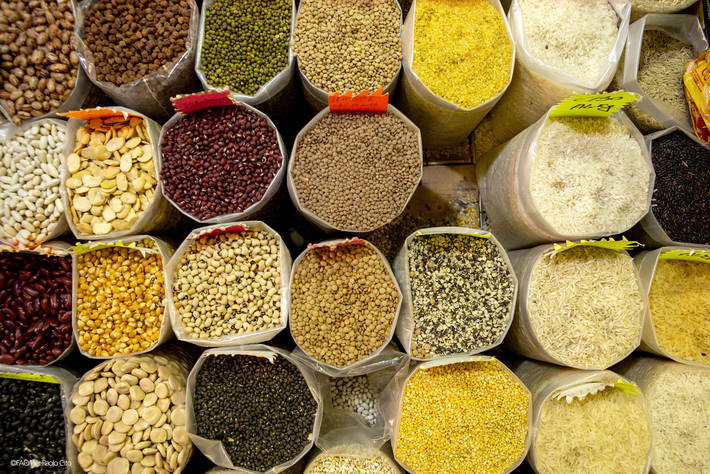Rome, Italy
10 December 2019
 A variety of pulses.
A variety of pulses.
FAO and the Global Pulse Confederation (GPC) today agreed on a three-year partnership to promote cultivation of foods such as lentils, dry beans, dry peas and chickpeas and to advocate for their high nutritional values.
The agreement "provides a framework for the FAO and the GPC to demonstrate leadership in the development of the global pulse sector", said Cindy Brown, Board President of the Global Pulse Confederation, which has 24 national association as well as 600 private-sector members.
For FAO, closer ties will build on the successful collaboration with the International Year of Pulses celebrated in 2016, for which the GPC became the main donor. The new partnership aims to move from advocacy to on-the-ground actions including a pilot programme in Burkina Faso and mapping out ways to leverage value chains for products such as cowpeas and Bambara beans.
"The way in which food is produced, transformed, delivered and consumed will be key in meeting a significant number of Sustainable Development Goals as well as generating adequate levels of employment and income in rural communities," said Daniel Gustafson, FAO Deputy Director-General for Programmes.
"Pulse crops are powerful tools that can help us meet the climate changes of the 21st century, these food crops represent a vital source of income for smallholder farmers and, at the same time, are a critical part of the sustainable agriculture systems that are needed to produce enough healthy, nutritious foods to sustain the world's growing population moving forward." said Brown.
What will be done
FAO and the GPC will work together to boost the visibility of World Pulses Day - February 10 - around the world, with the GPC using its networks to encourage greater private-sector participation.
They will also cooperate to identify at least three investment opportunities involving at least 1 000 smallholders each and pitching the plan to potential investors. To support that, FAO will conduct value-chain analyses using its AgrInvest framework in selected countries, while the GPC will analyse the discovered opportunities and propose business plans to investors and donors.
The AgrInvest approach leverages FAO's expertise to de-risk private-sector investment opportunities in agri-food systems and value chains of developing countries - where approximately three-quarters of the world's agricultural value-added activities take place - by conducting assessments and research and facilitating public-private policy dialogues.
The current partnership will directly support FAO's new Hand-in-Hand Initiative. Three months ago, the GPC committed to support FAO's Hand-In-Hand Initiative in Burkina Faso - where FAO is scouting out bankable opportunities where women's roles are significant - marking one of the first contributions to the new development approach championed by FAO Director-General Qu Dongyu.
More about pulses
Pulses are a subgroup of legume crops harvested for dried grains, and include lentils, chickpeas, dry beans, pigeon peas and other species. They are low in fat and sodium and free of both cholesterol and gluten, while punching above their size in terms of fibre, folate, potassium and plant-based protein and iron, winning them high marks for nutrition and increasing utilization in derivative products such as pasta noodles.
Pulses, like most legumes, are able to fix atmospheric nitrogen into the soil, which helps optimize the use of fertilizers and boosts soil health, making them of special interest in an era when climate change poses large risks to food security and livelihoods.
The partnership between FAO and the GPC aims to respond to the pressing need to close the large gap between potential and actual yields that afflicts many smallholder farms.
Export volumes of pulses have risen almost seven fold since 1971, indicating strong trade and rural income opportunities if farmers can gain access to markets, according to
The Global Economy of Pulses, published by FAO earlier this year. South Asia and sub-Saharan Africa together account for about half of global production.
Globally, about 21 grams of pulses are consumed per person each day, with much higher levels in Latin America, South Asia and sub-Saharan Africa offset by much lower levels in the rest of Asia, Europe and Oceania.